
A hearse is a large vehicle, originally a horse carriage but later with the introduction of motor vehicles, a car, used to carry the body of a deceased person in a coffin at a funeral, wake, or memorial service. They range from deliberately anonymous vehicles to heavily decorated vehicles.

A motorcycle is a two or three-wheeled motor vehicle steered by a handlebar from a saddle-style seat.

Minivan is a car classification for vehicles designed to transport passengers in the rear seating row(s), with reconfigurable seats in two or three rows. The equivalent classification in Europe is MPV. In Southeast Asia, the equivalent classification is Asian Utility Vehicle (AUV).

A coupe or coupé is a passenger car with a sloping or truncated rear roofline and two doors.
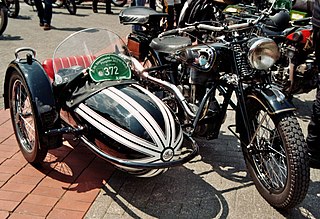
A sidecar is a one-wheeled device attached to the side of a motorcycle, scooter, or bicycle, making the whole a three-wheeled vehicle. A motorcycle with a sidecar is sometimes called a combination, an outfit, a rig or a hack.
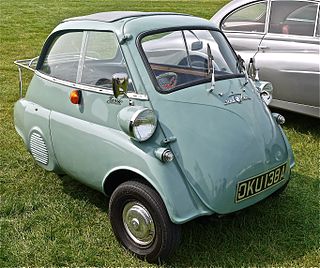
The Isetta is an Italian-designed microcar built under license in a number of different countries, including Argentina, Spain, Belgium, France, Brazil, Germany, and the United Kingdom. Because of its egg shape and bubble-like windows, it became known as a bubble car, a name also given to other similar vehicles.

An auto rickshaw is a motorized version of the pulled rickshaw or cycle rickshaw. Most have three wheels and do not tilt. They are known by many terms in various countries including auto, auto rickshaw, baby taxi, mototaxi, pigeon, jonnybee, bajaj, chand gari, lapa, tuk-tuk, tum-tum, Keke-napep, Maruwa, 3wheel, pragya, bao-bao, easy bike, CNG and tukxi.
There are many types of car body styles. They vary depending on intended use, market position, location, and the era they were made in.

Brough Superior motorcycles, sidecars, and motor cars were made by George Brough in his Brough Superior works on Haydn Road in Nottingham, England, from 1919 to 1940. The motorcycles were dubbed the "Rolls-Royce of Motorcycles" by H. D. Teague of The Motor Cycle newspaper. Approximately 3048 motorcycles were made in the 21 years of production; around a third of that production still exists. T. E. Lawrence owned eight of these motorcycles and died from injuries sustained when he crashed number seven; the eighth was on order. Moving forward to 2008, vintage motorcycle enthusiast Mark Upham acquired the rights to the Brough Superior name. In 2013 he met motorcycle designer Thierry Henriette and asked him to design a new Brough Superior motorcycle. Three months later a prototype of a new SS100 was shown in Milan.

A three-wheeler is a vehicle with three wheels. Some are motorized tricycles, which may be legally classed as motorcycles, while others are tricycles without a motor, some of which are human-powered vehicles and animal-powered vehicles.

A panel van, also known as a blind van, car-derived van or sedan delivery, is a small cargo vehicle with a passenger car chassis, typically with a single front bench seat and no side windows behind the B-pillar. Panel vans are smaller than panel trucks or cargo vans, both of which use body-on-frame truck chassis.
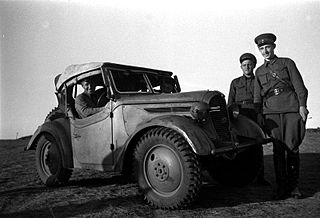
The Type 95 was a Japanese scout car built by Tokyu Kurogane Industries, and was used during the war with China and World War II in the East. Between 1936 and 1944 approximately 4,700 were built. It was the only completely Japanese designed reconnaissance car ever used by the Imperial Japanese Army, which tended to use civilian cars. Its nickname is the "Yonki" (よんき) which in Japanese means "all-wheel drive". In the field, soldiers often called it the "daruma" after the Buddhist symbol for good luck.
FIM Sidecar World Championship is the international sidecar racing championship. It is the only remaining original FIM road racing championship class that started in 1949.

A horse-drawn vehicle is a piece of equipment pulled by one or more horses. These vehicles typically have two or four wheels and were used to carry passengers or a load. They were once common worldwide, but they have mostly been replaced by automobiles and other forms of self-propelled transport but are still in use today.
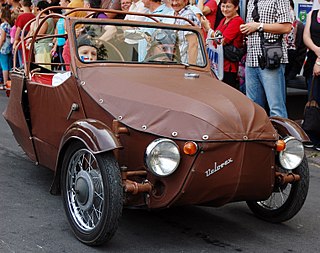
Velorex was a manufacturing cooperative in Solnice, Czechoslovakia. Notable products included a small three-wheeled car, produced from the 1950s until 1971, and the Type 562 sidecar. The sidecar is still manufactured in the Czech Republic by Velorexport, the successor to Velorex.

The Bat Motor Manufacturing Co. Ltd was a British motorcycle manufacturer that operated between 1902 and 1926. Significant innovations developed by the company included one of the first motorcycle suspension systems, with a leading link front fork and a subframe suspended on springs from the main frame.
Motorcycle accessories are features and accessories selected by a motorcycle owner to enhance safety, performance, or comfort, and may include anything from mobile electronics to sidecars and trailers. An accessory may be added at the factory by the original equipment manufacturer or purchased and installed by the owner post-sale as aftermarket goods. The term Farkle is used within the motorcycle community, originally to denote useful add-ons, such as GPS or other upgraded components. Now also used at times in a humorous or mildly derogatory way to describe bling, such as anodized or chromed parts that add no functionality.

In the Philippines, motorized tricycles, or simply tricycles, refer to a type of motorized vehicle consisting of a motorcycle and a passenger cab attached to it. Along with the jeepney, the Philippine tricycle is one of the most common means of public or private transportation in the country, especially in rural areas. These public utility vehicles either ply a set route or are for-hire, like taxis.
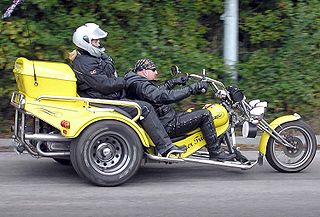
A motorized tricycle, motor trike, or motortrycle is a three-wheeled vehicle based on the same technology as a bicycle or motorcycle, and powered by an electric motor, motorcycle, scooter or car engine.

















